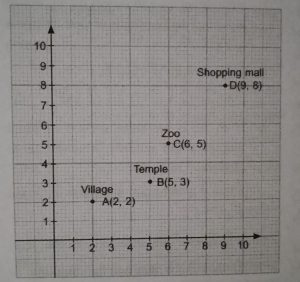Case study Chapter 9 ( Differential equation)
Case study 1: Read the following and answer the question(Case study Differential equation)
A veterinary doctor was examining a sick cat brought by a pet lover. When it was brought to the hospital, it was already dead. The pet lover wanted to find its time of death. He took the temperature of the cat at 11.30 pm which was 94.6° F. He took the temperature again after one hour; the temperature was lower than the first observation. It was 93.6° F The room in which the cat was put is always at 70° F. The normal temperature of the cat is taken as 98.6° F when it was alive. The doctor estimated the time of death using Newton law of cooling which is governed by the differential equation : ![]() , where 70° F is the room temperature and T is the temperature of the object at time t.
, where 70° F is the room temperature and T is the temperature of the object at time t.

Substituting the two different observation of T and t made, in the solution of the differential equation ![]() where k is a contant of proportion , time of death is calculated
where k is a contant of proportion , time of death is calculated
(i) State the degree of the above given differential equation.
(a) 0 (b) 1
(c) 2 (d) Not defined
(ii) Which method of solving a differential equation helped in calculation of the time of death
(a) Variable separable method
(b) Solving homogeneous differential equation
(c) Solving linear differential equation
(d) All of above
(iii) If the temperature was measured 2 hours after 11.30 pm, will the time of death change ?
(a) Yes (b) No
(c) Cannot be determined (d) None of these
(iv) The solution of differential equation ![]() is given by
is given by
(a) ![]() (b)
(b) ![]()
(c) ![]()
(d) ![]()
(v) If t=0 when T is 72, then the value of C is
(a) -2 (b) 0
(c) 2 (d) ![]()
Solution: (i) Answer(b)
We have differential equation
![]() with degree 1
with degree 1
(ii) Answer (a)
to solve the differential equation
![]()
Variable seperable method is useful.
(iii) Answer (b)
No, Time of death would not change.
(iv) Answer (a)
We have,
![]()
![]()
![]()
(v) Answer (d)
Given t = 0 when T = 72
Now, ![]()
![]()
![]()
Case study 2: Polio drops are delivered to 50K children in a district. The rate at which polio drops are given is directly proportional to the number of children who have not been administered the drops. By the end of 2nd week half the children have been given the polio drops. How many will have been given the drops by the end of 3rd weekcan be estimated using the solution to the differential equation ![]() where x denotes the number of weeks and y the number of children who have been given the drops.
where x denotes the number of weeks and y the number of children who have been given the drops.
Based on above information answer the following question.
(i) (a) Find the solution of the differential equation ![]() .
.
(b) Find the vcalue of C in the particular solution given that y(0) = 0 and k = 0.049.
(ii) Find the solution that may be used to find the number of children who have been given the polio drops.
Solution: (i)(a) We have,
![]()
![]()
![]()
(b) Given y(0) = 0 and k = 0.049
![]()
![]()
![]()
(ii) We have,
![]()
![]()
![]()
![]()
![]()
![]()
This is the required solution to find the number of children who have been given the polio drops.
43. An equation involving variables as well as derivative of the dependent variable with respect to only one independent variable is called an ordinary differential equation.
e.g. ![]()
from any given relationbetween the dependent and independent variable, a differential equation can be formed by differentiating it with respect to the independent variable and eliminating arbitrary constants involved.
(a) Find the degree of the differential equation ![]() .
.
(b) Find the order of differential equation![]() .
.
(c) Find the number of arbitrary constants in the general solution of a differential equation of third order.
(d) Find the differential equation of the family of lines through the origin.
(e) Find the degree of differential equation ![]()
Solution: (a) the highest order derivative is ![]() whose degree one. So, degree of differential equation is 1
whose degree one. So, degree of differential equation is 1
(b) The highest order derivative present in the differential equation is y”’.
Therefore, its order is 3.
(c) We know that the number of arbitrary constant in general solution of a differential equation of order n is equal to its order.
Therefore, the number of constants in the general equation of the third order differential equation is Three
(d) Let y = mx be the family of lines through the origin.
Therefore;
![]()
Eliminating m,
![]()
(e) Degree is not defined as differential equation can’t be written as polynomial of derivative.

